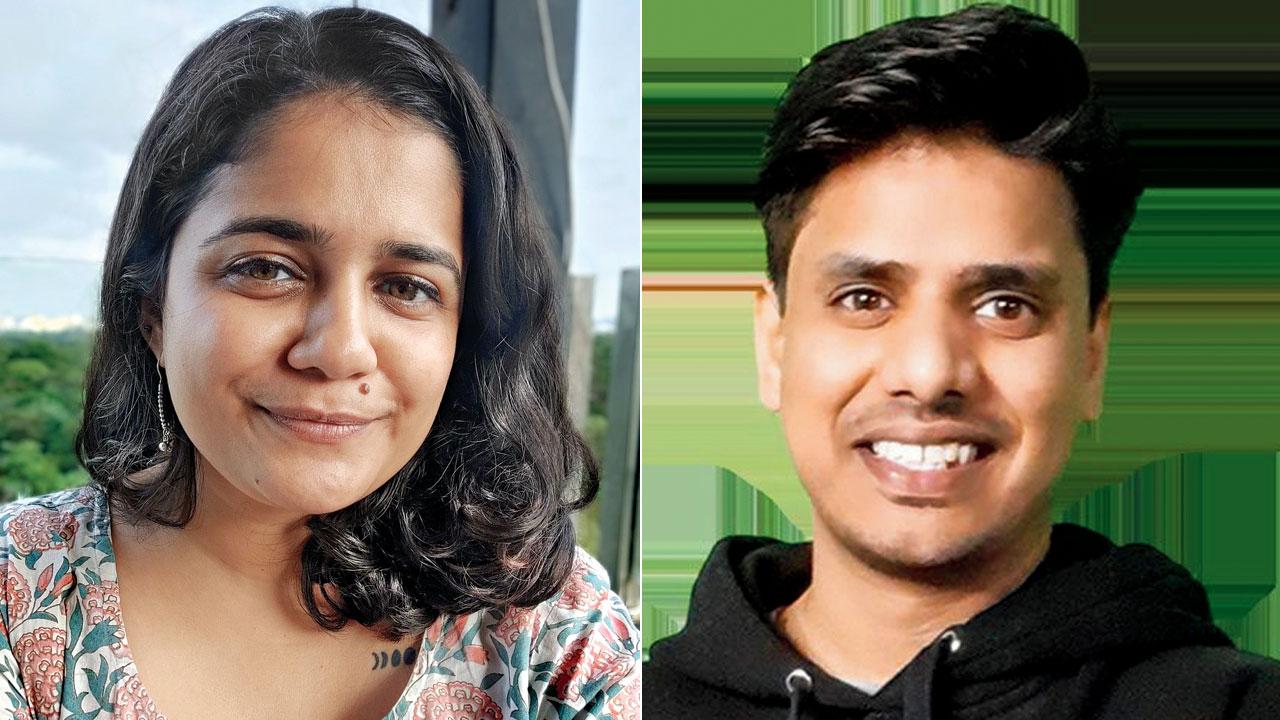Some of YouTube’s fastest growing channels are run by foreigners reacting to Indian content. And the Koreans have just joined the bandwagon once dominated by Brits, Africans and Pakistanis

Family who only identify as GeeksaMusing: GeeksaMusing; Moazzam and Iman Javed: Newsviewsupdates; Lomi, Josh Child and Miguel Sanchez: ChaatNChat; African friends only known as Dee & Vee: Dee & Vee
When he speaks, Josh Child has traces of an Indian accent. The barfi-lover has one of the fastest growing channels on YouTube, called ChaatNChat. On it, the 34-year-old visual effects (VFX) artist from Albuquerque reacts to regional Indian movies. He has gone from almost no followers to 35,000 subscribers in two months.
Child seemed a bit nervous over the phone. He is about to drop a video which will be a prelude to his reaction video along with his friend Miguel Sanchez, in Hindi, to the Sushant Singh Rajput-starrer Chhichhore. “I am a bit nervous,” he says. “I don’t want people to think that I am trying to pander to the audience for views; I want to do justice to Hindi.”
ADVERTISEMENT
Child is a recent entrant to the trend of non-Indians reacting to Indian content. The nationalities so far include, but are not limited to the Japanese, British, Australian, Malaysian and African YouTubers. They react to movies, iconic songs, or comic scenes.
 Illustration/Uday Mohite
Illustration/Uday Mohite
And it’s not a of-the-moment trend: It has had a dedicated space for three to four years, and refuses to die out. In fact, even more nationalities like Korean are
joining in.
“It’s the Westerner’s gaze on things that are out of context for them,” explains Rujuta Date, anthropologist and researcher. “There is an element of othering. If I had to make a cultural guess, I’d go back to the roots of anthropology when the discipline was formalised in the 19th century by armchair theorists. The early anthropologists relied on detailed notes and diaries maintained by travellers, missionaries, and merchants about the countries cultures they visited to make theories about the culture. For the longest time, the focus was on not on the self. Perhaps some level of amusement in these videos comes from a little bit of that: ‘Look at how incredulous this is. Look at how little of this we understand’.”
 Iman and Moazzam Javed started with a reaction video on Padmaavat in 2018 and were soon flooded with requests by Indians across the globe to do more
Iman and Moazzam Javed started with a reaction video on Padmaavat in 2018 and were soon flooded with requests by Indians across the globe to do more
And their subscribers are not just Indian either, but anyone with an affinity to the Indian subcontinent, such as Bangleshis and Pakistanis. But by the sheer virtue of Indians outnumbering other nationalities—we make up 17.76 per cent of the world population—we are YouTube’s highest users, 462 million strong. At second place is the United States with 239 million.
And these numbers, says social media strategist Rahul Maniar, are enough to sustain a trend. “As to why people love watching these [videos],” he says, “I guess it’s just another form of entertainment. And as Indians, we love validation, whether it’s music choices, TV shows or sports teams. These videos are basically a form of validation and become a fun way to discover new content as well.”
 Josh Child and Miguel Sanchez have formed an unlikely friendship as they bond over movies with Sanchez gaining the reputation to be the emotional “uncleji”
Josh Child and Miguel Sanchez have formed an unlikely friendship as they bond over movies with Sanchez gaining the reputation to be the emotional “uncleji”
Child’s case, though, is unique because the blonde-haired, soft-spoken American lived in Delhi’s Vasant Vihar from 2004 to 2010. “My father worked for the American Embassy and I came to love everything about India,” he chuckles. The then 14-year-old Child hung around the embassy’s playgrounds and struck up an unlikely friendship with an upholstery worker in a furniture store within the campus—Kedarnath Meena. Soon the teenager was having lunch with Meena and other workers, and began to learn Hindi. “When my father had to move from India, I moved in with Dadu (Meena) and his family,” says Child, “They are my adoptive family. I have brothers and sisters, and chacha and chachi, the whole Indian family, and we take turns visiting each other every year.”
In the October of 2023, Dadu visited Child in New Mexico and for a month, they binged on old movies such as Chupke Chupke and Paramveer. “When he was leaving, we both got emotional,” says Child, “I told him I would miss watching movies with him, and that’ when he said, ‘Make those reaction videos’. He said he would watch them back home, and it would be like watching the movie together.”
 Rujuta Date and Prashant Singh
Rujuta Date and Prashant Singh
He started on Instagram at first with some cooking and random videos, but no one was watching. Dadu reiterated his suggestion, and this time Child listened, and hasn’t looked back since.
There is no denying that India has a very tumultuous relationship with Pakistan. However, both have always found a common ground in Bollywood and Pakistani TV serials, and technology has nurtured that further.
 Rahul Maniar
Rahul Maniar
News, Views, & Updates is a reaction YouTube channel run by Lahore-based siblings Iman and Moazzam Javed. “We rarely get any negative reactions,” says Iman, a journalism graduate. A teacher until recently and now is a full time YouTuber. The sibling duo’s first reaction was way back in 2018 to Padmaavat. “We got a lot of comments and likes for it,” says Iman. “Soon, our subscribers began to suggest which movie to react to next.”
The siblings have also branched out from the movies to make videos titled ‘Pakistanis react to 50 Facts You Didn’t Know About MS Dhoni’ and ‘Pak Reacts To Gatiman Express Executive Class’. These garner comments such as, “It has been an addiction to watching your reaction videos since they appeared on my feed”. They have close to six lakh subscribers.
 Deena Pinto, Pankhuri Harikrishnan, Varun Gupta and Ishmeet Kaur Sethi
Deena Pinto, Pankhuri Harikrishnan, Varun Gupta and Ishmeet Kaur Sethi
“Since 2016-2017, there has been a sea change in the kind of technology available to us [in Pakistan],” says Moazzam, “which is when we also got to see videos about your movies and railways. Your network is just amazing. I wish we were able to reach the small corners of Pakistan like you. After Padmaavat, we got requests from subscribers, who were Indians, to look at so and so video and react. We were pleasantly surprised and more than happy to make them as culturally, we are quite similar.”
Being a reaction video maker on YouTube comes with its own set of challenges. “Recently, a person suggested I see a video, and I just couldn’t get to it,” says Child. “He would keep posting comments like, ‘27 days since Josh hasn’t seen the video I suggested’ and keep adding up the day. I just went like ‘I’ll get to it buddy’, but yeah that’s a bit challenging at times.”
Another pressure is to balance content that keeps subscribers happy and the freedom to try out new genres that could gain him more subscribers. “If I do, say, a Salman Khan movie, there is a spike in the number of subscribers immediately,” he says. “These ask me to do another Salman movie, but I need to switch content up to get more [subscribers] and therein lies the challenge. But I don’t mind it; I guess that means people are watching.”
Is this appreciation for Indian content all the time a good thing in the long run?
Prashant Singh, who runs the YouTube channel BeastStats, is one of the OG reaction video gurus from India. He tells us like it is: “We love to see people from other cultures react to ours. A person from Africa dancing to a Bollywood song is kind of novelty and we enjoy it.”
Ishmeet Kaur Sethi, a behaviourist and a life coach, has been viewing the foreigner reaction videos partly because for the feeling of patriotism they evoke as well as for pure research. “They often react to Indian food, tourist destinations, and even explainer videos on religions,” she says. “It gives you a zest. For example, I saw a video of people in awe of the Golden Temple. They (also) seem to value our family culture, and that does give me a sense of pride.”
These are also indicative of what the world thinks of India. “You get to know what is working about India, globally,” she says. “That’s good feedback for those who want to expand their business abroad, and human behaviourists. I often pause when the reaction is loudest and examine how I feel about it. One thing I really loved recently is a Pakistani man and woman reacting to Hinduism and Sikhism videos positively. You also understand the situation there is not like the narrative we’ve been told. Women seem to enjoy freedom as much as we do.”
When asked if he thinks the trend will be short-lived, Singh says, “I don’t think so. There might be changes in presentation, for example, a magician reacting to a Indian magician show or a foreign dancer reacting to an Indian dancing show, but the trend will not die down because there is a huge number of Indians on the internet. It’s a huge market for them to tap into.”
Currently, the foreign reaction industry seems to be massaging the Indian ego just so. “Indians who react to our content are more honest, whereas foreigners are more appreciative,” says Singh. “Recently, I saw two Korean sisters react to a Sanjay Leela Bhansali movie. They kept saying how beautiful the sets were and how beautiful Deepika (Padukone) looked. They go for the vibe. Indians are candid, we are open about the good and the bad, and even suggest some improvements. I think that’s the major difference between us and them.”
Pankhuri Harikrishnan, Founder and Director at Fetch! Consulting, a content, curation, and collaboration agency, adds another layer of insight. Currently, it’s cool to be desi and like all things desi—food, entertainment, culture.
“Bollywood is intriguing to everyone in any part of the world,” she says, “Everything about it—the drama, music, costumes—there’s nothing like it; And everyone knows it exists. Nobody obsesses about Hollywood like that. Additionally, the Indian diaspora is huge, and unlike in the past, it is not keen to adopt other cultures.
Earlier, the diaspora didn’t want to admit they were Indian. And Indian films are the biggest they’ve ever been. The Internet gives you a way to be part of this. Also with Indian actors collaborating [on equal footing] on international projects, anything Indian will open itself up to a new audience and high numbers.”
And where there are large numbers, monies follow. Maniar, who has worked in the field for 15 years, says the trend is also canny marketing.
“A few years ago, I realised that these reaction videos are proper marketing strategies,” he says, “We’ve had people do reaction videos for songs released by independent labels. The first one I ever saw one was a foreigner reacting to a new Hindi hip-hop song live on Twitch [a live-streaming platform], lyric by lyric. It wasn’t too long before the industry realised that fans and audiences love watching these. Now, we see so many comedians do it too. It’s at a point where agencies hire these guys, just like they hire influencers, to make content for their product. So in terms of foreigners making reaction videos to Bollywood segments, yes of course, Bollywood has a big fascination abroad, but in all likelihood, it could very well be a small part of a big marketing strategy.”
Ecommerce livestreamer Deena Pinto, who goes by the handle @skinnygirldiariez concurs: “It’s crazy how some can use clickbait to squeeze views out of us Indians. I don’t think this trend will go away any time soon. We as a nation are easily lured into the clickbait game; Indians love to be appreciated or praised, and [thus] fall for such videos.”
She gives the latest trend of foreigners using soundtracks from Indian movies to boost views. The comment sections are telling on fire with posts such as ‘Wow, thanks for using an Indian song’ or ‘So cool, you love our culture’. Pinto feels this makes it harder for Indian content creators to be authentic. “The quality of content has gone down drastically,” she says. “The more cringe the subject matter is, the better the reactions. It’s getting harder to keep up; the quantity of such videos is overtaking any videos we make.”
But Varun Gupta, who works as a brand and move strategist, says the videos work because foreigners usually give an authentic reaction. “An agency can reach out to them to review a new movie, but no money exchange hands,” he says. “Foreigners have nothing to gain or lose sitting in their country.”
And the (mistaken) assumption that foreigners don’t need money from Indians powers this industry. “To be honest,” says Gupta, “the Indian public feel there is a certain authenticity to a foreigner’s review due to the impression that they don’t need the money.”
Many channels, such as Geeks-a-Musing, where an American family reacts to videos of Coke Studio and even title tracks of movies such as Shamshera, are testament to the fact that whatever you may feel about their motivations—it’s fun to watch a foreigner get lost in our music and movies.
Dadu will soon visit Child for his annual holiday. “I’m going to take him on a cross-country trip,” says Child. “We plan to start from Colorado, head to Montana and then to California.” He also expects Dadu to try to convince him to marry a “nice Indian girl” this year. “He has been trying for a while now,” chuckles Child. On the other hand, the Javed siblings are trying to find sponsors for their India trip. “Unfortunately, it is still very difficult for us to travel to India,” says Moazzam, “Not only do we need someone to officially sponsor our trip, but they need to be verified and attested by the Indian embassy. We hope it gets easier for citizens of both countries to meet each other… sans the politics and vicious rhetoric.”
462M
Number of Indian YouTube users, the highest for any country
2.49BN
Global YouTube users
462MN
Indian YouTube users
What makes reaction videos so addictive?
Italian researchers found that when a macaque monkey reaches for food, certain neurons light up in its brain. Some hold these mirror neurons are active in humans too, and USC neuroscientist Lisa Aziz-Zadeh recently posited they could be a reason why we enjoy watching other people do things. “Mirror neurons are thought to contribute to social understanding,” Dr Aziz-Zadeh says, “and could explain why we feel empathy. By putting the self and the other on the same neural architecture, it has been postulated to be a neural architecture which may support social understanding and contribute to empathic processing.”
 Subscribe today by clicking the link and stay updated with the latest news!" Click here!
Subscribe today by clicking the link and stay updated with the latest news!" Click here!







